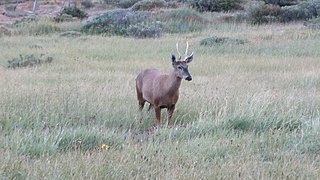
The Bromeliaceae are a family of monocot flowering plants of about 80 genera and 3700 known species, native mainly to the tropical Americas, with several species found in the American subtropics and one in tropical west Africa, Pitcairnia feliciana.
Cypress is a common name for various coniferous trees or shrubs of northern temperate regions that belong to the family Cupressaceae. The word cypress is derived from Old French cipres, which was imported from Latin cypressus, the latinisation of the Greek κυπάρισσος (kyparissos). Cypress trees are a large classification of conifers, encompassing the trees and shrubs from the cypress family (Cupressaceae) and many others with the word cypress in their common name. Many cypress trees have needle-like, evergreen foliage and acorn-like seed cones.

The Chilean dolphin, also known as the black dolphin, is one of four dolphins in the genus Cephalorhynchus. The dolphin is found only off the coast of Chile; it is commonly referred to in the country as tonina.

Darwin's fox or Darwin's zorro is an endangered canid from the genus Lycalopex. It is also known as the zorro chilote or zorro de Darwin in Spanish and lives on Nahuelbuta National Park, the Cordillera de Oncol, Cordillera Pelada in mainland Chile and Chiloé Island. This small, dark canine weighs 1.8 to 3.95 kg, has a head-and-body length of 48 to 59 cm and a tail that is 17.5 to 25.5 cm. Darwin's fox displays no key differences between male and female other than the fact that the male has a broader muzzle. Males display no territorial behavior and aren't aggressive towards other males roaming around their territory.

The marine otter is a rare and relatively unknown South American mammal of the weasel family (Mustelidae). The scientific name means "feline otter", and in Spanish, the marine otter is also often referred to as gato marino: "marine cat". The marine otter only lives in saltwater, coastal environments and rarely ventures into freshwater or estuarine habitats. This saltwater exclusivity is unlike most other otter species, except for the almost fully aquatic sea otter of the North Pacific.

The southern river otter is a species of otter that lives in Chile and Argentina. Although called a "river otter", it inhabits both marine and freshwater environments. It sometimes is considered a subspecies of Lontra canadensis. The southern river otter is listed as endangered, due to illegal hunting, water pollution, and habitat loss.

Greigia is a genus of plants in the family Bromeliaceae, subfamily Bromelioideae. It is native to Latin America from Mexico to Chile. The genus is named in honour of Major General Samuel Alexjewitsch Greig, president of the Russian Horticultural Society in 1865.

The south Andean deer, also known as the southern guemal, south Andean huemul, southern huemul, or Chilean huemul or güemul, is an endangered species of deer native to the mountains of Argentina and Chile. Along with the northern guemal or taruca, it is one of the two mid-sized deer in the Hippocamelus genus and ranges across the high mountainsides and cold valleys of the Andes. The distribution and habitat, behaviour, and diet of the deer have all been the subject of study. The viability of the small remaining population is an outstanding concern to researchers.
Greigia Atrobrunnea is a species of plant in the family Bromeliaceae. It is endemic to Ecuador, where it was first identified in 1981. It is a terrestrial bromeliad where the plants grow in groups. Its natural habitat is subtropical or tropical moist montane forests. It is threatened by habitat loss and was assessed as vulnerable by the International Union for Conservation of Nature in 2003.
Greigia sodiroana is a species of plant in the family Bromeliaceae. It is endemic to Ecuador. Its natural habitats are subtropical or tropical moist montane forests and subtropical or tropical high-altitude shrubland. It is threatened by habitat loss.

Islotes de Puñihuil Natural Monument is a Chilean Natural Monument located 28 km (17 mi) southwest of Ancud. It consists of three islets off the western coast of Chiloé Island to the west and north of Puñihuil.
Greigia ocellata is a plant species in the genus Greigia. It is also perennial.
Greigia oaxacana is a plant species in the genus Greigia. This species is endemic to Mexico.
Greigia berteroi is a species of flowering plant in the family Bromeliaceae. This species is endemic to the Juan Fernández Islands in the South Pacific, off the coast of Chile.

Greigia landbeckii is a plant species in the genus Greigia. It is endemic to Chile. A synonym is Bromelia landbeckii. Its common name is ñocha, and was traditionally used in wickerwork.

Greigia sphacelata is a plant species in the genus Greigia. This species is endemic to Chile. It is distributed between the Maule and Los Lagos regions. It produces edible fruits, known as 'chupones'.

Ochagavia litoralis is a species of flowering plant in the family Bromeliaceae. It is endemic to Chile. Its common names include calilla and chupón.
Greigia columbiana is a plant species in the genus Greigia. This species is native to Costa Rica, Panama, Colombia, Ecuador, and Venezuela.
Greigia mulfordii is a plant species in the genus Greigia. This species is native to Ecuador and Colombia.

Mario Jorge Baudoin Weeks was a Bolivian biologist and conservationist known for his research in Bolivia and Costa Rica. He was the first director of Bolivia's national park system, and served as director of several academic and government institutes, including the Museo Nacional de Historia Natural de Bolivia, the Institute of Ecology at Higher University of San Andrés, Dirección Nacional Conservación de Biodiversidad (DNCB) and the La Selva Biological Station in Costa Rica. In the early 1990s he was involved in the creation of the Servicio Nacional de Áreas Protegidas (SERNAP), which led to the 1995 establishment of Madidi National Park. He received the 2008 Distinguished Services Award from the Society for Conservation Biology.











